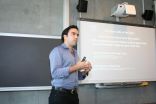(Press-News.org) For years physicists have been looking for the universe's elusive dark matter, but so far no one has seen any trace of it. Maybe we are looking in the wrong place? Now physicists from University of Southern Denmark propose a new technique to detect dark matter.
The universe consists of atoms and particles - and a whole lot more that still needs to be detected. We can only speculate about the existence of this unknown matter and energy.
"We know that app. 5 pct. of the universe consists of the known matter we are all made of. The rest is unknown. This unknown matter is called dark matter, and we believe that it is all around us, including here on Earth", explains Chris Kouvaris, associate professor at the Centre for Cosmology and Particle Physics Phenomenology (CP3-Origins), Department of Physics, Chemistry and Pharmacy, University of Southern Denmark.
He and his colleague from CP3-Origins, postdoc Ian Shoemaker, now suggest a new way to detect the existence of the elusive dark matter.
Cosmic noise is a problem
Over the last years, physicists have placed detectors in underground sites app. a kilometer or more deep in order to detect dark matter. The idea is that dark matter is easier to detect in deep sites because there is less noise from cosmic or Earth-produced radiation that can potentially cover the dark matter signal. This approach of detecting dark matter makes sense provided that dark matter interacts only a bit with atoms as it goes underground. The scientific term for this is that dark matter is weakly interacting with its surroundings.
"But we don't know if dark matter is that weakly interacting. In principle dark matter particles can lose energy as they travel underground before they hit the detector due to interactions with regular atoms. And in that case they might not have enough energy left to trigger the detector once they arrive there", says Chris Kouvaris.
Signals are good 12 hours a day
In a new research paper, he and Shoemaker study the possibility that dark matter can indeed interact substantially with atoms. They claim that depending on the properties of the dark matter particles, deep placed detectors can be blind because particles might have lost most of their energy before reaching the detector.
"In such a case, it would make more sense to look for dark matter signals on the surface of the Earth or in shallow sites", Kouvaris argues.
Placing a detector in shallow sites or on the surface ensures small energy loss for the dark matter particles but it also means a big increase in the background noise. This was after all the reason why detectors were placed in deep sites in the first place. To overcome this problem Kouvaris and Shoemaker propose - instead of trying to detect a single collision of a dark matter particle with the detector - to look for a signal that varies periodically during the day.
Because dark matter particles approach the detector from various directions, as the Earth rotates, the flux of the particles reaching the detector can vary. This causes a signal that will go from maximum to minimum in 12 hours and back to maximum again after another 12 hours.
Such a pattern will make the signals from dark matter stand out clear even though the detectors also pick up cosmic noise.
"The best locations for the observation of such a modulation signal are places in the south hemisphere with latitude around 40 degrees, such as Argentina, Chile and New Zealand" says Chris Kouvaris.
What is dark matter and dark energy?
27 pct. of the universe is believed to consist of dark matter. Dark matter is believed to be the "glue" that holds galaxies together. Nobody knows what dark matter really is.
5 pct. of the universe consists of known matter such as atoms and subatomic particles.
The rest of the universe is believed to consist of dark energy. Dark energy is believed to make the universe expand.
INFORMATION:
Ref: http://journals.aps.org/prd/abstract/10.1103/PhysRevD.90.095011
Contact Chris Kouvaris, phone (+45) 6550 2354. Email: kouvaris@cp3.dias.sdu.dk
In 1966, it was Roger Penrose who won the prestigious Adams Prize for his essay "An analysis of the structure of space-time." The Adams Prize - named after the British mathematician John Couch Adams - is awarded each year by the Faculty of Mathematics at the University of Cambridge to a young, UK-based mathematician. At the same time, Steven Hawking won an auxiliary to the Adams Prize for an essay entitled Singularities and the Geometry of Spacetime, shortly after completing his PhD. A copy of the original Hawking submission has now been reproduced in EPJ H.
That year, ...
"When the discovery was published back in September, we were certain that we had found a Viking ring fortress, but since then there have been intense discussions online and amongst archaeologists about whether we were right. Now we know without doubt that we have found a fortress from the 10th century," says archaeologist Nanna Holm, curator of the Danish Castle Centre.
Two carbon-14 dating results have removed all doubt regarding the authenticity of the Viking fortress. The carbon-14 dating was performed by the AMS 14C Dating Centre at the Department of Physics and Astronomy ...
HANOVER, N.H. - Dartmouth researchers and their colleagues have created an artificial intelligence software that uses photos to locate documents on the Internet with far greater accuracy than ever before.
The new system, which was tested on photos and is now being applied to videos, shows for the first time that a machine learning algorithm for image recognition and retrieval is accurate and efficient enough to improve large-scale document searches online. The system uses pixel data in images and potentially video - rather than just text -- to locate documents. It learns ...
The climate 150 million years ago of a large swath of the western United States was more complex than previously known, according to new research from Southern Methodist University, Dallas.
It's been thought that the climate during the Jurassic was fairly dry in New Mexico, then gradually transitioned to a wetter climate northward to Montana.
But based on new evidence, the theory of a gradual transition from a dry climate to a wetter one during the Jurassic doesn't tell the whole story, says SMU paleontologist Timothy S. Myers, lead author on the study.
Geochemical ...
You can't catch attention deficit hyperactivity disorder (ADHD). Yet the diagnosis and treatment of this behavioral condition is spreading like a contagion -- surging as much as tenfold in some countries.
Call it an economic and cultural plague, but not necessarily a medical one, says Brandeis professor Peter Conrad. In a recent paper in the journal Social Science and Medicine, Conrad and coauthor Meredith Bergey examined the growth of ADHD in the United Kingdom, Germany, France, Italy and Brazil.
Until recently, North America tallied by far the most ADHD diagnoses, ...
GAINESVILLE, Fla. --- Overhunting has been disastrous for elephants, but their forest habitats have also been caught in the crossfire.
A first-of-its-kind study led by researchers at the University of Florida shows that the dramatic loss of elephants, which disperse seeds after eating vegetation, is leading to the local extinction of a dominant tree species, with likely cascading effects for other forest life.
Their work shows that loss of animal seed dispersers increases the probability of tree extinction by more than tenfold over a 100-year period.
"The entire ...
LOS ANGELES (NOV. 17, 2014) - Researchers at the Cedars-Sinai Heart Institute have found that injections of cardiac stem cells might help reverse heart damage caused by Duchenne muscular dystrophy, potentially resulting in a longer life expectancy for patients with the chronic muscle-wasting disease.
The study results were presented today at a Breaking Basic Science presentation during the American Heart Association Scientific Sessions in Chicago. After laboratory mice with Duchenne muscular dystrophy were infused with cardiac stem cells, the mice showed steady, marked ...
Results of a new study challenge the current consensus in cardiology that peak myocardial edema, or heart muscle swelling, only occurs just after a myocardial infarction, or heart attack. In the study, presented as a Late-Breaking Clinical Trial at the American Heart Association (AHA) Scientific Sessions 2014 and published simultaneously in the Journal of the American College of Cardiology (JACC), scientists discovered a second wave of swelling and inflammation occurs within a week of a heart attack.
The researchers from the Mount Sinai Heart at Icahn School of Medicine ...
The findings of this international collaboration have been published today in Nature Genetics.
Progressive myoclonus epilepsies (PME) are rare, inherited, and usually childhood-onset neurodegenerative diseases whose core symptoms are epileptic seizures and debilitating involuntary muscle twitching (myoclonus).
Professor Berkovic said this finding of a new gene underlying progressive myoclonus epilepsy is one of the most devastating forms of epilepsy.
"For the study, we used modern DNA sequencing technologies, which have revolutionised genetic research of rare, severe ...
Anyone who has struggled with a foggy brain while adjusting to daylight saving time knows first-hand how an out-of-sync circadian clock can impair brain function.
Now, by manipulating the circadian clocks of Siberian hamsters, Stanford scientists may have identified a brain structure that disrupts memory when circadian rhythms fall apart, as they often do in patients with neurodegenerative diseases such as Alzheimer's.
"What we've been able to show is that the part of the brain that we absolutely know contains the circadian clock, the suprachiasmatic nucleus (SCN), ...



